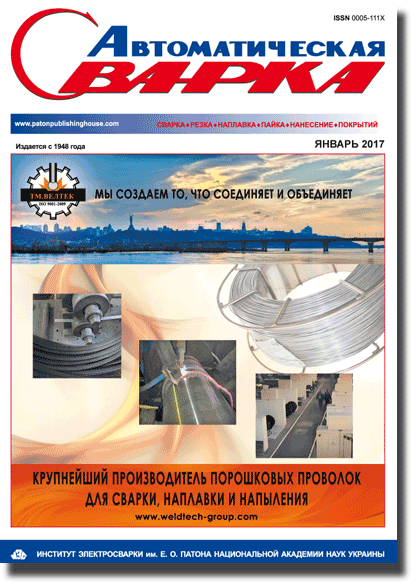| 2017 №01 (02) |
DOI of Article 10.15407/as2017.01.03 |
2017 №01 (04) |

Avtomaticheskaya Svarka (Automatic Welding), #1, 2017, pp. 26-34
Experimental studies of electrode coating thickness variation at pressing
A.E. Marchenko
E.O. Paton Electric Welding Institute, NASU 11 Kazimir Malevich Str., 03680, Kiev, Ukraine. E-mail: office@paton.kiev.ua
Abstract
Oscillographic and mathematical statistics methods were applied to study the regularities of formation of coating thickness variation in experimental electrodes UONI 13/55 with 4 mm rod diameter at their manufacture in angle hydraulic press under the conditions maximum close to production ones. It is found that coating thickness variation is a continuous, multistage, nonmonotonic (wavelike) and harmonic process, in which disturbances, arising at the starting stage, can be felt in subsequent stages of electrode pressing. Coating thickness variation is caused, primarily, by violation of elasticity and viscosity balance, on which the consistency of electrode coating masses depends. At the same time the probability of appearance of coating thickness variations is essentially influenced by the features of forming path of electrode coating press. 15 Ref., 7 Figures.
Keywords: arc welding, coated electrodes, pressing, coating thickness variation, oscillography, mathematical statistics
Received: 16.02.17
Published: 28.11.16
References
- Vornovitsky, I.N. (1989) Thickness variation as a basic factor of electrode quality. Proizvodstvo, 4, 7–9.
- Marchenko, A.E. (2000) Thickness variation as a factor of process state and quality of manufacture of welding electrodes. In: Proc. of Scient.-Techn. Seminar on Electrode Manufacturing at the Turn of New Millenium (St.-Petersburg, 22-26 May, 2000). Cherepovets: Association «Elektrod», 124–125.
- Marchenko, A.E. (2014) Thickness difference of electrode coatings caused by elastic turbulence of electrode compounds under condition of nonisothermal pressure flow. The Paton Welding J., 6/7, 177–189. https://doi.org/10.15407/tpwj2014.06.38
- Marchenko, A.E. (2015) Investigation of elasto-plastic characteristics of electrode coating masses in the state of pressure flow through cylindrical forming nozzles. In: of Int. Sci.-Techn. Conf. on Welding Consumables. Petranievsky readings (St.-Petersburg, 15–17 Oct. 2015), 79–89.
- Marchenko, A.E. (2016) Rheological investigations of non-isothermal pressure flows of coating mixtures for welding electrodes. The Paton Welding J., 1, 1–19. https://doi.org/10.15407/tpwj2016.01.03
- Stepanosov, A.R. (1989) Expert evaluation of causes of thickness variation in welding electrode coating. Proizvodstvo, 4, 9–11.
- Vornovitsky, I.N. (2001) Quality control of welding electrodes in their manufacture process. Moscow: IKAR.
- Marchenko, A.E. (1993) Peculiarities of formation of coating thickness variation detected by oscillography. In: of Pap. of Int. Sci.-Techn. Conf. on Welding Metallurgy and Consumables (St.-Petersburg, 1–2 June 1993), 98–100.
- Paton, B.E., Pokhodnya, I.K. (1961) Welding equipment in Great Britain. Svarka, 6, 75–92.
- Sakata Shiro (1980) Practical guidelines on quality control. Ed. by V.I.Gostev. Moscow: Mashinostroenie.
- Redderger, P.J., Charles, M.E. (1962) Axial laminar flow in a circular pipe with a fixed core. of Chemical Engineering, Aug., 148–151.
- Happel, J. (1976) Hydrodynamics at Reynolds small numbers. Moscow: Mir.
- Marchenko, A.E. (2015) On heat pattern created by viscous heating of electrode coating mass in the zone of pressure flow forming. In: of Int. Sci.-Techn. Conf. on Welding Consumables. Petranievsky readings (St.-Petersburg, 15–17 Oct. 2015), 65–78.
- Vinogradov, G.V., Malkin, A.Ya. (1977) Rheology of polymers. Moscow: Khimiya.
- Marchenko, A.E. (2010) On physical-chemical nature of electrode coating strength and technological ways ensuring it. In: of 5th Int. Conf. on Welding Consumables. Technologies. Manufacturing. Quality. Competitiveness (Artyomovsk, 7–11 June, 2010). Kiev, 2010, 78–99.
The cost of subscription/purchase order journals or individual articles
| Journal/Currency | Annual Set | 1 issue printed |
1 issue |
one article |
| TPWJ/USD | 384 $ | 32 $ | 26 $ | 13 $ |
| TPWJ/EUR | 348 € | 29 € | 24 € | 12 € |
| TPWJ/UAH | 7200 UAH | 600 UAH | 600 UAH | 280 UAH |
| AS/UAH | 1800 UAH | 300 UAH | 300 UAH | 150 UAH |
| AS/USD | 192 $ | 32 $ | 26 $ | 13 $ |
| AS/EUR | 180 € | 30 € | 25 € | 12 € |
| SEM/UAH | 1200 UAH | 300 UAH | 300 UAH | 150 UAH |
| SEM/USD | 128 $ | 32 $ | 26 $ | 13 $ |
| SEM/EUR | 120 € | 30 € | 25 € | 12 € |
| TDNK/UAH | 1200 UAH | 300 UAH | 300 UAH | 150 UAH |
| TDNK/USD | 128 $ | 32 $ | 26 $ | 13 $ |
| TDNK/EUR | 120 € | 30 € | 25 € | 15 € |
AS = «Automatic Welding» - 6 issues per year;
TPWJ = «PATON WELDING JOURNAL» - 12 issues per year;
SEM = «Electrometallurgy Today» - 4 issues per year;
TDNK = «Technical Diagnostics and Non-Destructive Testing» - 4 issues per year.





